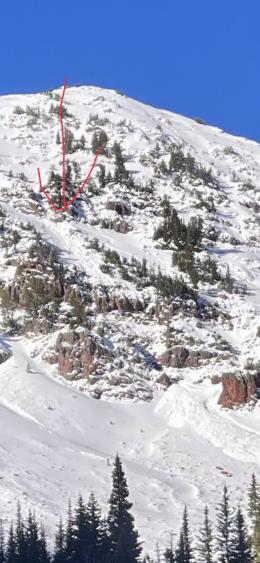Good morning. This is Doug Chabot with pre-season avalanche, weather and event information for the Gallatin National Forest Avalanche Center on Thanksgiving Day, November 23rd, at 6:30 a.m. This information is sponsored by Spark R&D and Klim and will be updated tomorrow.
Last night 4” fell up Hyalite and 1-2” around Big Sky and Bridger ski areas. Wind is north to northeast at 5-15 mph with mountain temperatures near 20F. Three days ago the mountains received 2-3”, which is outlined in our daily log. Another inch may fall today before sunny skies and high pressure return tomorrow into mid-week. We are patiently waiting for the ember of winter to be blown into a full flame.
There is enough snow on the ground to avalanche in specific areas, namely high elevation gullies. Skiers will have to walk far to get into these areas and snowmobilers are still a big storm or two away from firing up their sleds. Hunters and ice climbers, on the other hand, are the most exposed. Even a little wind could load gullies with pillows of snow that could avalanche. While technically small, these are the types of avalanches that can kill. Many gullies lead to cliffs, and the debris, because it’s confined, can quickly get deep. If you cross a gully, avoid the smooth whales of snow that the wind piled up like a sand dune, and only cross one at a time. The most snow that fell last night (4”) occurred up Hyalite which happens to be where the ice climbs are.
Early season snow is the foundation of our winter snowpack. As a general rule, thin snow cover (less than 2 feet) and below freezing temperatures change the snow into weak grains of sugary, faceted crystals. These may be underneath the new windblown snow and could avalanche. Seeing cracks shoot out in front of your feet are a warning to not go further.
General Public Service Announcement: Carry rescue gear and know how to use it if you are heading onto steep, snow covered slopes. A sturdy shovel, probe and avalanche transceiver for everyone in the party is a minimum. And only expose one person at a time to avalanche terrain because there’s no sense in everyone getting caught.
Drop us a line and let us know what you find. It does not need to be technical. Did you se ant avalanches? How much snow is on the ground? Was the wind blowing and moving snow? Simple observations are incredibly valuable. If you get out, please share avalanche, snowpack or weather observations via our website, email (mtavalanche@gmail.com), phone (406-587-6984), or Instagram (#gnfacobs).
There is enough snow on the ground to avalanche in specific areas, namely high elevation gullies. Skiers will have to walk far to get into these areas and snowmobilers are still a big storm or two away from firing up their sleds. Hunters and ice climbers, on the other hand, are the most exposed. Even a little wind could load gullies with pillows of snow that could avalanche. While technically small, these are the types of avalanches that can kill.
A week ago, Ian saw evidence that the 20” of snow at 8800’ is weakening at our Sawtelle Weather Station. This will be the foundation of this season’s snowpack (observation and photos).
Upcoming Avalanche Education and Events
Our education calendar is full of awareness lectures and field courses. Check it out: Events and Education Calendar.
We are offering an Avalanche Fundamentals with Field Session course targeted towards non-motorized users in December and January, and one geared towards motorized users in January. Sign up early before they fill up.
We travel with a lot of electronics that could interfere with our avalanche transceiver, both as a victim and as a rescuer. Check out our article on Electronic Warfare to learn what to do.


